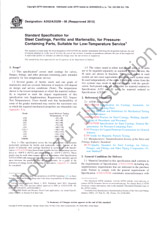Wir benötigen Ihre Einwilligung zur Verwendung der einzelnen Daten, damit Sie unter anderem Informationen zu Ihren Interessen einsehen können. Klicken Sie auf "OK", um Ihre Zustimmung zu erteilen.
ASTM E3031-15
Standard Test Method for Determination of Antibacterial Activity on Ceramic Surfaces
Automatische name übersetzung:
Standard Test Methode zur Bestimmung der antibakteriellen Aktivität auf Keramikoberflächen
NORM herausgegeben am 15.10.2015
Informationen über die Norm:
Bezeichnung normen: ASTM E3031-15
Anmerkung: UNGÜLTIG
Ausgabedatum normen: 15.10.2015
SKU: NS-622468
Zahl der Seiten: 5
Gewicht ca.: 15 g (0.03 Pfund)
Land: Amerikanische technische Norm
Kategorie: Technische Normen ASTM
Kategorie - ähnliche Normen:
Die Annotation des Normtextes ASTM E3031-15 :
Keywords:
antimicrobial, antibacterial, antibacterial glaze, ceramic, quantitative antibacterial assay, tile,, ICS Number Code 81.060.20 (Ceramic products)
Ergänzende Informationen
| Significance and Use | ||||||||||||
|
5.1 Current solid surface test methodologies, such as the Test Method E2180 and ISO 22196, do not take into account the complexities associated with a ceramic surface. This includes, but is not limited to, differing chemistries incorporated into the glaze and desiccation due to water absorption through the bisque body. Each point will be elaborated below: 5.1.1 The glaze composition of ceramic tiles can vary between manufacturers, lots, and product lines. Some glaze chemistries such as tin, silver and copper can negatively impact the testing conditions. Therefore, an untreated tile from the same lot is not always suitable for comparison. The control tile proposed herein is capable of supporting growth over the indicated time frame and nutrient level (see Section 9). 5.1.2 Desiccation is a common problem when testing tile surfaces. This can be overcome by pre-hydrating the tile by placing the specimen on a moistened wipe and allowing incubation for 18 to 24 h before beginning the test. This reduces the number of false positive results and more accurately measures the ability of the antimicrobial to inhibit growth. 5.2 This test method utilizes a low inoculum load and requires growth on the control substrate to demonstrate a valid testing environment. In addition, while some antimicrobials demonstrate activity against static cultures, others require growth of the bacteria to maintain activity. A low inoculum level will allow for both types of antimicrobials to be examined with the same testing conditions. |
||||||||||||
| 1. Scope | ||||||||||||
|
1.1 This method is designed to quantitatively evaluate the antibacterial activity of glazed ceramic surfaces that have been specifically designed to contain an antibacterial treatment as part of the glaze. This test method is meant to compare the efficacy of one ceramic surface to another ceramic surface using the stated conditions and is not meant to be extrapolated to other conditions. 1.2 Knowledge of microbiological techniques is required for this test. 1.3 The values stated in SI units are to be regarded as standard. No other units of measurement are included in this standard. 1.4 This standard does not purport to address all of the safety concerns, if any, associated with its use. It is the responsibility of the user of this standard to establish appropriate safety and health practices and determine the applicability of regulatory limitations prior to use. |
||||||||||||
| 2. Referenced Documents | ||||||||||||
|
Empfehlungen:
Aktualisierung der technischen Normen
Wollen Sie sich sicher sein, dass Sie nur die gültigen technischen Normen verwenden?
Wir bieten Ihnen eine Lösung, die Ihnen eine Monatsübersicht über die Aktualität der von Ihnen angewandten Normen sicher stellt.
Brauchen Sie mehr Informationen? Sehen Sie sich diese Seite an.




 Cookies
Cookies
